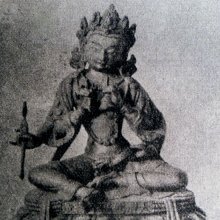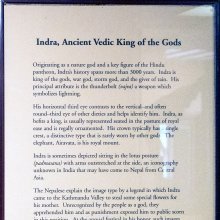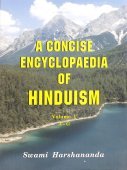Airavata, Airāvata, Āirāvata, Aīrāvata: 30 definitions
Introduction:
Airavata means something in Buddhism, Pali, Hinduism, Sanskrit, Jainism, Prakrit, the history of ancient India, Marathi, Hindi, biology. If you want to know the exact meaning, history, etymology or English translation of this term then check out the descriptions on this page. Add your comment or reference to a book if you want to contribute to this summary article.
Alternative spellings of this word include Eravat.
Images (photo gallery)
In Hinduism
Vastushastra (architecture)
Source: Wisdom Library: Vāstu-śāstraAirāvata (ऐरावत) refers to a type of temple (prāsāda) classified under the group named Sāndhāra, according to Samarāṅgaṇasūtradhāra chapter 56. The Sāndhāra group contains twenty-five out of a sixty-four total prāsādas (temples) classified under four groups in this chapter. The Samarāṅgaṇasūtradhāra is an 11th-century encyclopedia dealing with various topics from the Vāstuśāstra.
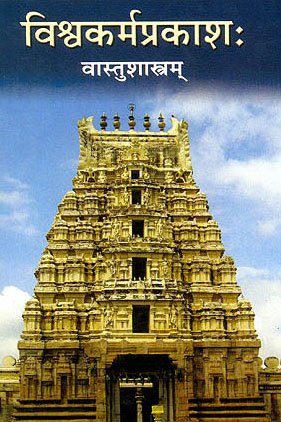
Vastushastra (वास्तुशास्त्र, vāstuśāstra) refers to the ancient Indian science (shastra) of architecture (vastu), dealing with topics such architecture, sculpture, town-building, fort building and various other constructions. Vastu also deals with the philosophy of the architectural relation with the cosmic universe.
Purana and Itihasa (epic history)
Source: Wisdom Library: Varāha-purāṇaAirāvata (ऐरावत).—Name of a minor mountain (kṣudraparvata) situated in Bhārata, a region south of mount Meru, according to the Varāhapurāṇa chapter 85. In the settlements (janapada) along these mountains dwell Āryas and Mlecchas who drink water from the rivers flowing there. Meru is one of the seven mountains located in Jambūdvīpa, which is ruled over by Āgnīdhra, a grandson of Svāyambhuva Manu, who was created by Brahmā, who was in turn created by Nārāyaṇa, the unknowable all-pervasive primordial being, who was created by Brahmā, who was in turn created by Nārāyaṇa, the unknowable all-pervasive primordial being.
Source: archive.org: Puranic Encyclopedia1) Airāvata (ऐरावत).—A large elephant, son of Irāvatī. Genealogy. Descended from Viṣṇu in this order:—Viṣṇu-Brahmā-Kaśyapa-Bhadramatā-Irāvatī-Airāvata. Kaśyapa married Dakṣa’s daughter, Krodhavaśā who bore him ten daughters. They were: Mṛgī, Mṛgamandā, Harī, Bhadramatā, Mātaṅgī, Śārdūlī, Svetā, Surabhī, Sarasā and Kadru. Of these Bhadramatā had a daughter named Irāvatī and Airāvata was her son. Airāvata was not human in shape; he was a large elephant. (See Sarga 14, Araṇyakāṇḍa, Rāmāyaṇa). (See full article at Story of Airāvata from the Puranic encyclopaedia by Vettam Mani)
2) Airāvata (ऐरावत).—Name of a serpent born to Kaśyapa and his wife Kadru. This is mentioned in Śloka 5, Chapter 35, Ādi Parva of the Mahābhārata. Arjuna’s father-in-law and Ulūpi’s father, Kauravya belonged to the family of this serpent. (See Śloka 18, Chapter 213, Ādi Parva).
3) Airāvata (ऐरावत).—An asura who was killed by Śrī Kṛṣṇa. (See Chapter 38, Sabhā Parva, Mahābhārata).
Source: archive.org: Shiva Purana - English TranslationAirāvata (ऐरावत) refers to the white elephant of Indra, according to the Śivapurāṇa 2.3.15 (“The penance and reign of Tārakāsura”).—Accordingly, after Tāraka requested boons from Brahmā: “[...] That great demon [i.e., Tāraka] was crowned the king of the three worlds with the permission of Śukra, the preceptor of the demons. [...] Then the demon Tāraka seized gems and jewels of all the guardians of the quarters, Indra and others, offered under duress by them on being afraid of him. Afraid of him, Indra surrendered his Airāvata (white elephant) and Kubera all his nine treasures. White horses were surrendered by Varuṇa, the wish-yielding cow Kāmadhenu by the sages, and the sun out of fear for him surrendered his divine horse Uccaiḥśravas. [...]”.
Source: Cologne Digital Sanskrit Dictionaries: The Purana Index1) Āirāvata (आइरावत).—A species of white elephants with four tusks;1 the elephant of Indra.2 Lord of elephants; travelling in the sun's chariot during the month of kārtika;3 Indra rode on, to see Kṛṣṇa;4 defeated by Garuḍa in a fight between Kṛṣṇa and Indra.5
- 1) Bhāgavata-purāṇa, X. 59. 37.
- 2) Viṣṇu-purāṇa I. 9. 7, 25; 22. 5.
- 3) Viṣṇu-purāṇa II. 10. 12.
- 4) Viṣṇu-purāṇa V. 12. 2. 13 and 25; 29. 1.
- 5) Viṣṇu-purāṇa V. 30. 66.
2) Aīrāvata (अईरावत).—The Nāga presiding over the month of tapasya (phalguna);1 with the sun in the śarat.2
- 1) Bhāgavata-purāṇa XII. 11. 40; Brahmāṇḍa-purāṇa II. 23. 3 and 14; III. 7. 33 and 327; Matsya-purāṇa 6. 39; 126. 15.
- 2) Vāyu-purāṇa 52. 14; 69. 70.
3a) Airāvata (ऐरावत).—Bhauvana got hold of the sun's aṇḍakapāla and sang the rathantara portion of Sāmagāna when an elephant appeared given to Irāvati as son. Hence Airāvata the vehicle of Indra—the first king among elephants;1 fourteen tusks;2 Indra's mount; defeated by Vṛtra;3 came out of the amṛtamathana;4 sacred.5
- 1) Vāyu-purāṇa 69. 209-11; Matsya-purāṇa 8. 7.
- 2) Bhāgavata-purāṇa VI. 11. 11; Matsya-purāṇa 133. 10; 177. 48.
- 3) Bhāgavata-purāṇa VIII. 8. 4; X. 25. 7.
- 4) Ib. VIII. 8. 4.
- 5) Bhāgavata-purāṇa XI. 16. 17.
3b) The uttarasthāna; has three roads or vīthis.*
- * Vāyu-purāṇa 66. 47-48.
Airāvata (ऐरावत) is a name mentioned in the Mahābhārata (cf. I.33.2, I.31.5, I.35, I.52.11, I.60.60) and represents one of the many proper names used for people and places. Note: The Mahābhārata (mentioning Airāvata) is a Sanskrit epic poem consisting of 100,000 ślokas (metrical verses) and is over 2000 years old.
Source: Shodhganga: Kasyapa Samhita—Text on Visha Chikitsa (itihasa)Airāvata is the name of a Serpent (sarpa) mentioned in the thirty-fifth chapter (verses 4-17) of the Ādiparva of the Mahābhārata.—Accordingly, Sauti, on being implored by Śaunaka to name all the serpents in the course of the sarpa-sattra, tells him that it is humanly impossible to give a complete list because of their sheer multiplicity; but would name the prominent ones in accordance with their significance [e.g., Airāvata].

The Purana (पुराण, purāṇas) refers to Sanskrit literature preserving ancient India’s vast cultural history, including historical legends, religious ceremonies, various arts and sciences. The eighteen mahapuranas total over 400,000 shlokas (metrical couplets) and date to at least several centuries BCE.
Vaishnavism (Vaishava dharma)
Source: Pure Bhakti: Bhagavad-gita (4th edition)Airāvata (ऐरावत) refers to “lord Indra’s elephant carrier”. (cf. Glossary page from Śrīmad-Bhagavad-Gītā).
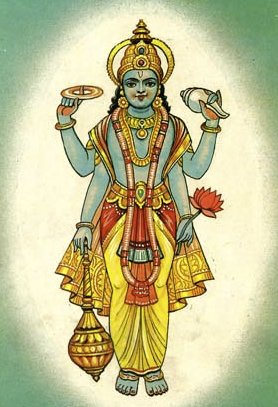
Vaishnava (वैष्णव, vaiṣṇava) or vaishnavism (vaiṣṇavism) represents a tradition of Hinduism worshipping Vishnu as the supreme Lord. Similar to the Shaktism and Shaivism traditions, Vaishnavism also developed as an individual movement, famous for its exposition of the dashavatara (‘ten avatars of Vishnu’).
Jyotisha (astronomy and astrology)
Source: Wisdom Library: Brihat Samhita by VarahamihiraAirāvata (ऐरावत) or Airāvatavīthi refers to one the nine divisions of the ecliptic, according to the Bṛhatsaṃhitā (chapter 9), an encyclopedic Sanskrit work written by Varāhamihira mainly focusing on the science of ancient Indian astronomy astronomy (Jyotiṣa).—Accordingly, “The ecliptic is divided into nine divisions known as Vīthis (paths), According to some each division consists of three constellations beginning from Aśvini. [...] According to others the Airāvata Vīthi consists of the constellations of the three from Punaravasu; [...]”.
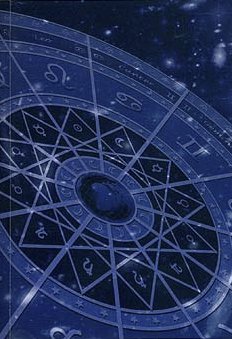
Jyotisha (ज्योतिष, jyotiṣa or jyotish) refers to ‘astronomy’ or “Vedic astrology” and represents the fifth of the six Vedangas (additional sciences to be studied along with the Vedas). Jyotisha concerns itself with the study and prediction of the movements of celestial bodies, in order to calculate the auspicious time for rituals and ceremonies.
General definition (in Hinduism)
Source: Wisdom Library: HinduismAirāvata (ऐरावत, “born-of-the-ocean”):—The first mount of Indra, and represents an elephant with four tusks. Indra is the king of the gods. He is the ruler of the storm and represents the all-pervading electric energy. As a major deity in the Ṛg-veda, he also represents the cause of fertility.
Source: WikiPedia: HinduismAirāvata (ऐरावत): Indra's elephant.
In Buddhism
Mahayana (major branch of Buddhism)
Source: archive.org: Bulletin of the French School of the Far East (volume 5)Airāvata (ऐरावत) is the name of a Nāgarāja appointed as one of the Divine protector deities of Gandhāra, according to chapter 17 of the Candragarbha: the 55th section of the Mahāsaṃnipāta-sūtra, a large compilation of Sūtras (texts) in Mahāyāna Buddhism partly available in Sanskrit, Tibetan and Chinese.—In the Candragarbhasūtra, the Bhagavat invites all classes of Gods and Deities to protect the Law [dharma?] and the faithful in their respective kingdoms of Jambudvīpa [e.g., the Nāgarāja Airāvata in Gandhāra], resembling the time of the past Buddhas.

Mahayana (महायान, mahāyāna) is a major branch of Buddhism focusing on the path of a Bodhisattva (spiritual aspirants/ enlightened beings). Extant literature is vast and primarely composed in the Sanskrit language. There are many sūtras of which some of the earliest are the various Prajñāpāramitā sūtras.
In Jainism
General definition (in Jainism)
Source: Wisdom Library: JainismAirāvata (ऐरावत).—One of the seven regions (kṣetra) of Jambūdvīpa according to Jaina cosmology. Jambūdvīpa sits at the centre of madhyaloka (‘middle world’) is the most important of all continents and it is here where human beings reside. In Airāvata flows the twin rivers Raktā and Raktodā.
Source: archive.org: TrisastisalakapurusacaritraAirāvata (ऐरावत) (or Airāvatakṣetra, Airāvatavarṣa) refers to one of the seven zones of Jambūdvīpa which is situated in the “middle world” (madhyaloka), according to chapter 2.2 [ajitanātha-caritra] of Hemacandra’s 11th century Triṣaṣṭiśalākāpuruṣacaritra: an ancient Sanskrit epic poem narrating the history and legends of sixty-three illustrious persons in Jainism.
Accordingly:—“Now, there are 7 zones here in Jambūdvīpa: Bhārata, Haimavata, Harivarṣa, Videha, Ramyaka, Hairaṇyavata, and Airāvata from south to north. Making the division between these there are 7 mountain-ranges, bounding the zones: Himavat, Mahāhimavat, Niṣadha, Nīla, Rukmin, and Śikharin with equal diameter at the base and top. [...] In the zone named Airāvata there are the great rivers, Raktā and Raktodā; [...] The first of each pair flows to the east and the second to the west. [...]”.
Source: Encyclopedia of Jainism: Tattvartha Sutra 3: The Lower and middle worldsAirāvata (ऐरावत) or Airāvatavarṣa refers to a region of Jambūdvīpa: the first continent of the Madhya-loka (middle-word), according to the 2nd-century Tattvārthasūtra 3.10. Due to its association with the Kṣatriya King Airāvata, this region is called Airāvatakṣetra. The mountain chain Śikhari separates the Hairaṇyavata and Airāvata regions. The Rivers Raktā and Raktodā divide Airāvata-kṣetra.
Bharata, Airāvata and Videha except Uttarakuru and Devakuru are the regions of labour i.e. where spiritual effort is possible also. There are 15 regions of labour in the Two-and-half continents (dhāi-dvīpa) namely; five in Bharata, five in Airāvata and five in Videha regions. The region where the inhabitants engage themselves in the six activities /occupations are called region of labour. The Human beings living in the regions of labour are called inhabitants of the region of labour (karmabhūmija).
Jambūdvīpa (containing the Airāvata region) is in the centre of all continents and oceans; all continents and oceans are concentric circles with Jambūdvīpa in the centre. Like the navel is in the centre of the body, Jambūdvīpa is in the centre of all continents and oceans. Sumeru Mount is in the centre of Jambūdvīpa. It is also called Mount Sudarśana.

Jainism is an Indian religion of Dharma whose doctrine revolves around harmlessness (ahimsa) towards every living being. The two major branches (Digambara and Svetambara) of Jainism stimulate self-control (or, shramana, ‘self-reliance’) and spiritual development through a path of peace for the soul to progess to the ultimate goal.
India history and geography
Source: Cologne Digital Sanskrit Dictionaries: Indian Epigraphical GlossaryAirāvata.—(IE 7-1-2), ‘one’; sometimes hastin, etc., are used in this sense though they really mean ‘seven’. Note: airāvata is defined in the “Indian epigraphical glossary” as it can be found on ancient inscriptions commonly written in Sanskrit, Prakrit or Dravidian languages.

The history of India traces the identification of countries, villages, towns and other regions of India, as well as mythology, zoology, royal dynasties, rulers, tribes, local festivities and traditions and regional languages. Ancient India enjoyed religious freedom and encourages the path of Dharma, a concept common to Buddhism, Hinduism, and Jainism.
Biology (plants and animals)
Source: Google Books: CRC World Dictionary (Regional names)Airavata in India is the name of a plant defined with Citrus aurantium in various botanical sources. This page contains potential references in Ayurveda, modern medicine, and other folk traditions or local practices It has the synonym Citrus amara Link (among others).
Example references for further research on medicinal uses or toxicity (see latin names for full list):
· Species Plantarum (1753)
· Plant Systematics and Evolution (1984)
· Revista Brasileira de Genética (1997)
· Annales du muséum national d’histoire naturelle (1813)
· Phytomorphology (1998)
· Annales des Sciences Naturelles; Botanique (1843)
If you are looking for specific details regarding Airavata, for example extract dosage, pregnancy safety, chemical composition, side effects, diet and recipes, health benefits, have a look at these references.

This sections includes definitions from the five kingdoms of living things: Animals, Plants, Fungi, Protists and Monera. It will include both the official binomial nomenclature (scientific names usually in Latin) as well as regional spellings and variants.
Languages of India and abroad
Marathi-English dictionary
Source: DDSA: The Molesworth Marathi and English Dictionaryairāvata (ऐरावत).—m (S) pop. airāvatī m The name of Indra's elephant. Pr. indrācā ai0 śāmbhaṭācī taṭāṇī.
Source: DDSA: The Aryabhusan school dictionary, Marathi-Englishairāvata (ऐरावत) [-tī, -ती].—m The name of Indra's elephant.
Marathi is an Indo-European language having over 70 million native speakers people in (predominantly) Maharashtra India. Marathi, like many other Indo-Aryan languages, evolved from early forms of Prakrit, which itself is a subset of Sanskrit, one of the most ancient languages of the world.
Sanskrit dictionary
Source: DDSA: The practical Sanskrit-English dictionaryAirāvata (ऐरावत).—[irā āpaḥ tadvān irāvān samudraḥ tasmādutpannaḥ aṇ]
1) Name of the elephant of Indra. ऐरावतं गजेन्द्राणाम् (airāvataṃ gajendrāṇām) Bhagavadgītā (Bombay) 1.27.
2) An excellent elephant; a species of elephant; ऐरावतानैन्द्रशिरान्नागान्वै प्रियदर्शनान् (airāvatānaindraśirānnāgānvai priyadarśanān) Rām.2.7.23.
3) One of the chiefs of the Nāgas or serpent-race (inhabiting Pātāla); अहमैरावत ज्येष्ठभ्रातृभ्योऽकरवं नमः (ahamairāvata jyeṣṭhabhrātṛbhyo'karavaṃ namaḥ) Mahābhārata (Bombay) 1.3.139.
4) The elephant presiding over the east.
5) A kind of rainbow.
6) A kind of lightning; (said to be n. also in these two senses).
7) The orange tree.
-tam 1 A vast and waterless region.
2) (pl.) Name of a Varṣa.
3) Name of the northern path of the moon.
4) A kind of cloud; 'मेघस्योपरि मेघो यः स ऐरावत उच्यते (meghasyopari megho yaḥ sa airāvata ucyate)' इति दक्षिणावर्तः (iti dakṣiṇāvartaḥ) (Commentator of meghadūta).
-tī 1 The female of Indra's elephant.
2) Lightning.
3) Name of a plant (vaṭapatrī)
4) Name of river Rāvi in the Panjab (= irāvatī).
5) Name of a particular portion of the moon's path.
Derivable forms: airāvataḥ (ऐरावतः).
Source: Cologne Digital Sanskrit Dictionaries: Edgerton Buddhist Hybrid Sanskrit DictionaryAirāvata (ऐरावत).—m., name of a mountain (= next; occurs as name of several mountains in Brahmanical and Jain Sanskrit, see Kirfel, [Kosmographie der Inder], Index s.v.): Divyāvadāna 450.11.
Source: Cologne Digital Sanskrit Dictionaries: Shabda-Sagara Sanskrit-English DictionaryAirāvata (ऐरावत).—m.
(-taḥ) 1. Indra'S elephant. 2. The same, considered as the elephant of the north quarter. 3. An orange. 4. A fruit, (Artocarpus lacucha.) 5. A serpent, one of the chiefs of the Naga or serpent race, inhabiting the infernal regions. f. (-tī) 1. Lightning. 2. A particular kind of it. 3. The female of Indra'S elephant. 4. The Ravi river in the Panjab. n.
(-taṃ) Indra'S bow unbent, the rainbow. E. irāvat water-having; that is, the ocean, a cloud, &c. aṇ affix implying origin or descent; born from the ocean, (the elephant,) proceeding from watery clouds, (lightning, &c.)
Source: Cologne Digital Sanskrit Dictionaries: Benfey Sanskrit-English DictionaryAirāvata (ऐरावत).—i. e. irāvant + a (see the last), I. m. 1. Indra's elephant, considered as the elephant of the east quarter, Mahābhārata 1, 2627. 2. A kind of elephant, [Rāmāyaṇa] 2, 70, 22. 3. A patronymic name of a Nāga, Mahābhārata 1, 829. 4. The name of the northern path of the moon, Mahābhārata 3, 11836. Ii. m. and n. A particular shape of the rainbow, Ragh, 1, 36. Iii. m., f. tī, and n. Lightning, Mahābhārata 13, 7391. Iv. m. The orange-tree; n. its fruit, [Suśruta] 1, 211, 11. V. f. tī, The name of a river, Mahābhārata 8, 2055.
Source: Cologne Digital Sanskrit Dictionaries: Cappeller Sanskrit-English DictionaryAirāvata (ऐरावत).—[masculine] the same; also [Name] of a fabulous serpent-demon.
Source: Cologne Digital Sanskrit Dictionaries: Monier-Williams Sanskrit-English Dictionary1) Airāvata (ऐरावत):—[from aira] m. ([from] irā-vat), a descendant of Irā-vat
2) [v.s. ...] Name of a Nāga or mythical serpent, [Atharva-veda viii, 10, 29; Tāṇḍya-brāhmaṇa; Mahābhārata; Harivaṃśa] etc.
3) [v.s. ...] ‘produced from the ocean’, Name of Indra’s elephant (considered as the prototype of the elephant race and the supporter of the east quarter; cf. nāga, which means also elephant and serpent), [Mahābhārata; Raghuvaṃśa; Meghadūta] etc.
4) [v.s. ...] a species of elephant, [Rāmāyaṇa ii, 70, 23]
5) [v.s. ...] the tree Artocarpus Lacucha
6) [v.s. ...] the orange tree, [cf. Lexicographers, esp. such as amarasiṃha, halāyudha, hemacandra, etc.]
7) [v.s. ...] Name of a particular portion of the moon’s path
8) [v.s. ...] of a form of the sun, [Viṣṇu-purāṇa; Mahābhārata]
9) [v.s. ...] mn. a kind of rainbow, [Mahābhārata; Raghuvaṃśa] etc.
10) [from aira] f(ī, ā). a particular portion of the moon’s path (including the lunar mansions Punarvasu, Puṣya, and Āśleṣa), [Varāha-mihira’s Bṛhat-saṃhitā]
11) [v.s. ...] n. the fruit of Artocarpus Lacucha, [Suśruta]
12) [v.s. ...] Name of a Varṣa, [Mahābhārata]
Source: Cologne Digital Sanskrit Dictionaries: Yates Sanskrit-English DictionaryAirāvata (ऐरावत):—(taḥ) 1. m. Idem. n. His bow unbent. tī f. Lighting.
Source: DDSA: Paia-sadda-mahannavo; a comprehensive Prakrit Hindi dictionary (S)Airāvata (ऐरावत) in the Sanskrit language is related to the Prakrit words: Airāvaya, Eravaya, Erāvaya.
[Sanskrit to German]
Sanskrit, also spelled संस्कृतम् (saṃskṛtam), is an ancient language of India commonly seen as the grandmother of the Indo-European language family (even English!). Closely allied with Prakrit and Pali, Sanskrit is more exhaustive in both grammar and terms and has the most extensive collection of literature in the world, greatly surpassing its sister-languages Greek and Latin.
Hindi dictionary
Source: DDSA: A practical Hindi-English dictionaryAirāvata (ऐरावत) [Also spelled eravat]:—(nm) the mythological elephant of Indra, Chief of gods.
...
Kannada-English dictionary
Source: Alar: Kannada-English corpusAirāvata (ಐರಾವತ):—
1) [noun] (myth.) Indra's elephant; the elephant that is supposed to be the guardian of the north quarter of the universe.
2) [noun] any excellent elephant.
3) [noun] (Jain.) one of the seven mythological territories or nations.
4) [noun] the orange tree; Citrus aurantium (=C. bergamia) of Rutaceae family.
5) [noun] the tree Psidium guajava (=P. pyriferum) of Myrtaceae family.
6) [noun] its fruit; guava.
Kannada is a Dravidian language (as opposed to the Indo-European language family) mainly spoken in the southwestern region of India.
See also (Relevant definitions)
Starts with: Airavatagaja, Airavataghatta, Airavatah, Airavataka, Airavatakshetra, Airavatam, Airavatatirtha, Airavatavarsha, Airavatavithi, Airavatopanishad, Airāvata-go-rājya.
Full-text (+209): Eravaya, Abhramu, Caturdanta, Nagamalla, Airavatam, Gajagrani, Abhramuvallabha, Bhadramanas, Arkasodara, Indrakunjara, Shvetakunjara, Airavataka, Rakta, Jaratkarna, Indra, Abhramatanga, Abhramupriya, Shvetahastin, Gajendra, Airavana.
Relevant text
Search found 73 books and stories containing Airavata, Airāvata, Āirāvata, Aīrāvata; (plurals include: Airavatas, Airāvatas, Āirāvatas, Aīrāvatas). You can also click to the full overview containing English textual excerpts. Below are direct links for the most relevant articles:
Garga Samhita (English) (by Danavir Goswami)
Verse 3.2.24 < [Chapter 2 - The Great Festival of Śrī Girirāja]
Verses 1.7.42-45 < [Chapter 7 - Description of the Conquest of All Directions]
Verse 3.4.9 < [Chapter 4 - The Coronation-Bathing of Śrī Kṛṣṇa]
Shrimad Bhagavad-gita (by Narayana Gosvami)
Verse 10.27 < [Chapter 10 - Vibhūti-yoga (appreciating the opulences of the Supreme Lord)]
Amarakoshodghatana of Kshirasvamin (study) (by A. Yamuna Devi)
Mythical Informations < [Chapter 4 - Cultural Aspects]
Gods and Divinities < [Chapter 4 - Cultural Aspects]
Rig Veda (translation and commentary) (by H. H. Wilson)
Tattvartha Sutra (with commentary) (by Vijay K. Jain)
Verse 3.28 - The nature of the other regions < [Chapter 3 - The Lower World and the Middle World]
Verse 3.27 - The rise (regeneration) and fall (degeneration) < [Chapter 3 - The Lower World and the Middle World]
Verse 3.37 - The regions of labour (karmabhūmi) < [Chapter 3 - The Lower World and the Middle World]
Puranic encyclopaedia (by Vettam Mani)
Related products
